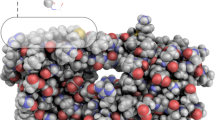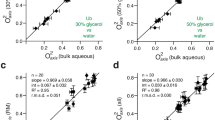Abstract
A COMPLETE description of an enzyme requires a knowledge of its structure and the dynamics of its function. From the crystal structures of enzymes and enzyme–inhibitor complexes and the known chemistry of model systems, it has been possible in some cases to draw reasonable inferences concerning the mechanisms of enzyme-catalysed reactions. Little has been done so far, however, to supplement such essentially static results by an investigation of the reaction dynamics. This requires an understanding of the internal motions of the enzyme, as well as those of the substrate, since both are likely to be essential to the function. Here we present a theoretical study of a low frequency vibration involving the two globular lobes of lysozyme between which the cleft containing the active site is located1. Any motion involving this cleft could play a part in the catalytic activity; in fact, atom displacements of up to 0.75 Å found in a comparison of the free enzyme and the enzyme-inhibitor complex indicate that the cleft has closed down in the latter2. The force constant for the low frequency bending vibration corresponding to the opening and closing of the cleft is obtained from empirical energy functions3. Because the protein surface moves appreciably during the vibration, damping effects resulting from the viscous dissipation in the solvent are included in the calculation4,5.
This is a preview of subscription content, access via your institution
Access options
Subscribe to this journal
Receive 51 print issues and online access
$199.00 per year
only $3.90 per issue
Buy this article
- Purchase on Springer Link
- Instant access to full article PDF
Prices may be subject to local taxes which are calculated during checkout
Similar content being viewed by others
References
Blake, C. C. F., Mair, G. A., North, A. C. T., Phillips, D. C., and Sarma, V. R., Proc. R. Soc., B 167, 365–377 (1967).
Imoto, T., Johnson, L. N., North, A. C. T., and Rupley, J. A., in The Enzymes, VII (edit. by Boyer, P. D.), (Academic, New York, 1972).
Gelin, B. R., and Karplus, M., Proc. natn. Acad. Sci. U.S.A., 72, 2002–2006 (1975).
deGennes, P. G., and Papoular, M., in Polarization, Materiere et Rayonnement (Presses Universitaire de France, Paris, 1969).
Suezaki, Y., and Go, N., Int. J. Peptide and Protein Res., 7, 333–334 (1975).
Dickerson, R. E., and Geis, I., The Structure and Action of Proteins (Benjamin, Menlo Park, California, 1969).
Chandrasekhar, S., Rev. mod. Phys., 15, 1–89 (1943).
Diamond, R., J. molec. Biol., 82, 371–391 (1974).
Honig, E. P., Roebersen, G. J., and Wiersema, P. H., J. Colloid Interface Sci., 36, 97–109 (1971).
Happel, J., and Brenner, H., Low Reynolds Number Hydrodynamics, 54 (Prentice-Hall, Englewood Clifts, New Jersey, 1965).
Landau, L. D., and Lifshitz, E. M., Fluid Mechanics (Pergamon, London, 1959).
Rahman, A., and Stillinger, F. H., Phys. Rev. A, 10, 368–378 (1974).
Matthews, B. W., in The Proteins, 3 (edit. by Neurath, H., and Mill, R. L.), (Academic, New York, 1972).
Edmundson, A. B., Ely, K. R., Abola, E. E., Schiffer, M., and Panagiotopoulos, N., Biochemistry, 14, 3953–3961 (1975).
Colman, P. M., Deisenhofer, J., Huber, R., and Palm, W., J. molec. Biol., 100, 257–282 (1976).
Yguerabide, J., Epstein, H. F., and Stryer, L., J. molec. Biol., 51, 573–590 (1970).
Perutz, M., Nature, 228, 726–739 (1970).
Morgan, R. S., and Peticolas, W. L., Int. J. Peptide Protein Res., 7, 361–365 (1975).
Genzel, L., et al., Biopolymers, 15, 219–225 (1976).
Author information
Authors and Affiliations
Rights and permissions
About this article
Cite this article
MCCAMMON, J., GELIN, B., KARPLUS, M. et al. The hinge-bending mode in lysozyme. Nature 262, 325–326 (1976). https://doi.org/10.1038/262325a0
Received:
Accepted:
Published:
Issue Date:
DOI: https://doi.org/10.1038/262325a0
This article is cited by
-
Mapping protein dynamics at high spatial resolution with temperature-jump X-ray crystallography
Nature Chemistry (2023)
-
Diffuse X-ray scattering from correlated motions in a protein crystal
Nature Communications (2020)
-
THz time scale structural rearrangements and binding modes in lysozyme-ligand interactions
Journal of Biological Physics (2014)
-
Low-temperature molecular dynamics simulations of horse heart cytochrome c and comparison with inelastic neutron scattering data
European Biophysics Journal (2013)
-
Fractional stochastic description of hinge motions in single protein molecules
Chinese Science Bulletin (2011)
Comments
By submitting a comment you agree to abide by our Terms and Community Guidelines. If you find something abusive or that does not comply with our terms or guidelines please flag it as inappropriate.



